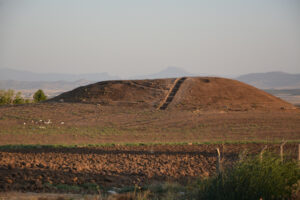Area B
Area B
Area B – located on the northern slope of Mound B – was excavated in 2015 and 2016. The aim of excavations in this area, originally laid out as a step trench, was to record the complete stratigraphy of the mound. For this purpose, a trench 23 m long and 1.5 m wide was excavated in 2015. In 2016, work was carried out at individual points inside the step trench and in a new trench to the east.

Late Burials
In the area of the hilltop, several burials were uncovered just below the surface. A distinction was made between four different types of burials, spread over two layers. In the older layer, only skeletons in a lateral position were found. The deceased were roughly facing south, so it can be assumed that they were Islamic believers.
